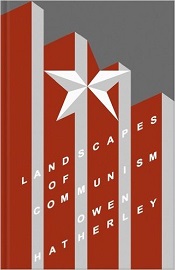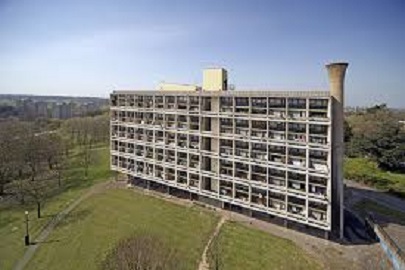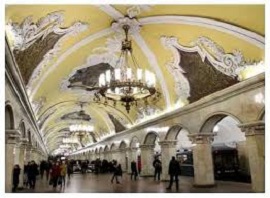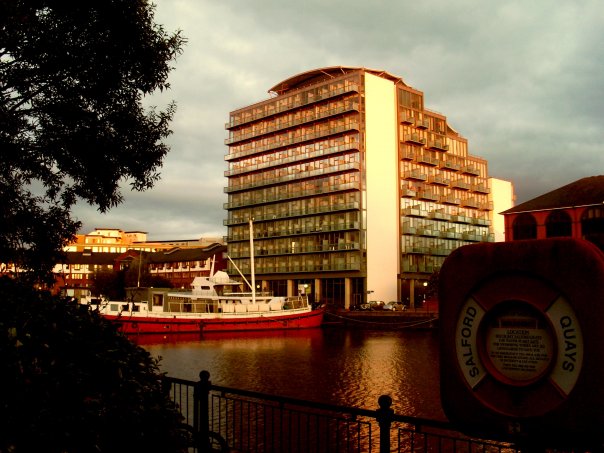Main author
Michael BrooksOwen Hatherley interview
Since he burst onto the scene in 2009 with his book of polemical essays ‘Militant Modernism’, Owen Hatherley has come to be seen as one of Britain's most forthright and acerbic writers on architecture and the built environment.
His books ‘A Guide to the New Ruins of Great Britain’ and ‘A New Kind of Bleak’ sought to analyse and critique the legacy left by New Labour’s decade of ‘urban regeneration’, winning plaudits from writers such as Will Self and Phillip Pullman. He is also a writer for The Guardian, Architects Journal, Dezeen, New Humanist and the London Review of Books.
Earlier this year, Hatherley published ‘Landscapes of Communism’, an ambitious travelogue of his wanderings around the former Eastern bloc countries examining what the architecture and urban planning of the Soviet Union and other regimes says about those same countries today.
Designing Buildings Wiki met with Owen Hatherley in a Woolwich cafe to discuss communist architecture, contemporary British attitudes to Brutalism, the damaging effects of the social cleansing of London, and more.
Read Designing Buildings Wiki’s review of ‘Landscapes of Communism’ here.
[edit] 
| Designing Buildings Wiki (DBW): Just by way of introduction, what is it would you say about the way you approach, think and write about the built environment that differs from other writers on the subject? |
Owen Hatherley (OH):
Well, I’m not a specialist, in a field that is very much dominated by specialists. I have no architectural qualifications at all, which obviously shows at times, but my background is in history and politics. I have a lot of personal political baggage which I initially used to inform what I began to write about the built environment and I guess it has all just progressed from there. All architecture is political anyway.
| DBW: When you ask someone to envisage the ‘landscapes of communism’ it’s not difficult to guess at what sort of things they will be thinking about. While a lot of these preconceptions are explored, and in many instances confirmed, in the book, there are a fair few surprises as well. Was there a particular place on your travels that surprised your own preconceptions? |
OH:
The most surprising thing I found was the attitude towards the historic city which, with a few exceptions, was by-and-large far more sympathetic than the rest of Western Europe during the same period.
In the post-war decade, various cities – Warsaw, St. Petersburg, Gdansk – were reconstructed in a way that never happened here, the Netherlands, Germany, or France. Of course if you go deeper into it, you can see where they were making it up a little bit, because total reconstruction is impossible, but they had a very good go.
Then there was a period in the 1960/70s where it came much closer to a Western European Modernist norm - they started off reconstructing Dresden as a baroque city in the 40s and 50s, then in the 60s and 70s they decided to build it in a Modernist way, then in the 80s they started reconstructing it again, and they’ve kept doing it ever since.
I think it comes partly out of a rejection, implicit or otherwise, of the contradiction between John Ruskin and William Morris, of authenticity as an important value in architecture. You can follow this to the Bauhaus, you can follow it to Brutalism if you want, or follow it to Arts and Crafts, but each of those is of no interest to the communist states. To me this seems ironic given that Ruskin was heavily anti-capitalist and Morris was an outright Marxist, but their ideas of how to preserve buildings had no influence whatsoever.
| DBW: In terms of the ‘social condenser’ – a place that combines multiple social utilities – you highlight the Bulgarian coastal resort. What was it about there that identified it as such? Was it the lack of expectation you attached to it perhaps? |
OH:
Yes, it was a place called Albena near Varna. The interesting thing about that was the fact that everything’s been laid on in a very high density area, every kind of amenity has been provided, and it all overlaps each other as well. I don’t think it’s a strict social condenser but it is insofar that every space is a public space.
| DBW: Did you get a sense as you were exploring the microrayons (housing estates) of how satisfying or successful they were as places to exist in day-to-day? |
OH:
Really good question … something like Bukowinska in Warsaw seems very pleasant, the blocks have all been insulated, everything’s cleaned up, the public spaces have been restored, and they’re very nice actually, certainly more so than they would have been after they’d been built.
Whereas if you go to Georgia, the blocks in your average microrayon have all been extended, so you’ve got these extruded steel frames on which people have inserted their own little shanty town, and these are apocalyptic to look at!
It really depends on the maintenance, on the city and the area of the city that you’re in. But especially in the earliest of the pre-fab housing schemes they were probably better planned than in the UK. The school, the poly clinic, the sports centre, the cinema - they would all be planned as part of each one and connected together, there would be a tram line that would get you into town and frequently a metro line.
It’s interesting to compare something like the Alton Estate [Roehampton] which was architecturally a great project but had appalling public transport links, or Thamesmead. Places like that were really badly connected to the rest of the city, whereas in Warsaw, the planning worked. So it does vary, and indeed some of them are horrible.
| DBW: Do you think it has anything to do with the fact that those estates and that architecture may not have faced the same stigmatisation as in the UK? |
OH:
Well yes, it’s hard to stigmatise something that almost everyone lives in. And also because all the Eastern blocs didn’t have social housing, they just had housing that was generally state-provided or co-operatively provided, where doctors and the like lived and still do unless they played the market well in the 1990s. So they were genuinely mixed class and that’s probably why there isn’t so much of a stigma about them.
| DBW: I particularly enjoyed the chapter on memorials. It’s striking if you go to Moscow…the dichotomies that are present between, on the one hand, all the Soviet iconography, and on the other, the high capitalism, designer boutiques, shopping malls, etc. Do you see this as being evidence of the communist past assuming a sort of confusing nostalgia there now? |
OH:
I think it’s partly that. But also it is healthy insofar as it’s part of people’s history so I think it’s quite natural. I know people in the west seem to be excessively shocked by it, but just because they may be nostalgic for the Soviet Union doesn’t mean they’re nostalgic for the Great Purge of 1937. It’s more like they’re nostalgic for the sense of security that they perhaps haven’t felt since the early 1990s.
And of course, if capitalism can sell anything it will, so the average Moscow boutique or corner shop will have boxes full of branded products that evoke the ‘glorious past’, precisely as they do here.
| DBW: Difficult question - if you could encapsulate the architectural style and legacy of communism in one building or structure what would it be? |
OH:
Completely impossible!
The Moscow metro is well up there, but there you’re seeing communist architecture at its best not most typical.
If I had to I’d probably go for the area around the Karl-Marx-Allee and Stalinallee in what was East Berlin. There you have multiple phases that began straight after the war with Hans Scharoun planning it in a Modernist 1920s-style. Then in 1953, the workers started rioting because their minimum norms were suddenly raised, so it was a worker’s protest against the thing that was supposed to glorify the workers. Then they completed the neoclassical parade and after that it went Modernist.
It has various pavilions, cinemas and facilities that are all quite interesting. It has the Stalinist pomposity, grandiose monuments along it, the workers protest, the Postmodernist 1960s ideas, it has pre-fab, and it’s now very desirable with fashionable young people. It has some of the good and the bad about it.
| DBW: What are your thoughts on the apparently confused attitude the British have to their own Brutalist architecture? On the one hand, it is denigrated and demolished – the last of the Red Road flats came down the other week – and on the other hand, the Park Hill estate wins the Sterling Prize and places like Trellick Tower and the Barbican are icons in their own right. How do you make sense of these opposing attitudes? |
OH:
In terms of architectural historians and so on, the point of preservation has always been to pinpoint the high quality, bespoke, one-off, individual buildings like Park Hill or Trellick Tower as a way of disassociating the architectural style from Ranon Point, the Aylesbury estate or Red Road.
A lot of it is listed and preserved now, the odd one gets away like Birmingham Library, but by-and-large even though Brutalism is not universally popular, there is a sense that people know it’s pretty good now.
One really important thing of that era was the provision of mass housing, which wasn’t always done by Erno Goldfinger or whoever; it was usually done by local authorities. The basic architecture of the era – the ordinary terraces and semis – is much less well preserved, as the basic architecture of any era always is.
The thing about Red Road is a tricky one. No one would ever preserve Red Road as great architecture, and in fact it wasn’t Brutalist at all, it was quite Soviet, like something from the suburbs of Moscow. You’d approach Glasgow and see the skyline – the councilors, or rulers in general, always have the view that ‘this is a working city and this is not what we want’.
A lot of the hierarchy of the Labour Party, people who cut their teeth in the 1980s when social housing was seen as ‘the worst thing ever’, somehow haven’t got the memo that actually its worth defending what their party did in housing millions of people in the 60s and 70s. But the huge assault on social housing that has been happening in the last 30 years and especially in the last 5 years… it’s now a real mess.
| DBW: Do you think this failure to adequately provide social housing in the UK comes out of the fact that we recoil from the notion of such regimented ‘assembly line’ accommodation such as is found in the Eastern bloc microrayons? Is it a reflection of the capitalistic tendency to perceived individualism extended to the housing sector that didn’t exist in the same way in communist states? |
OH:
I think it runs very deep anyway in the fact that, historically, England never had people living in flats. Before the war it was very rare, bits of Liverpool, bits of inner London, and Barrow-in-Furness! Other than that, houses were the norm for a very long time, so when Thatcherism happened it fell on really fertile ground.
I think there is an Anglo-Saxon thing about it, and when privatisation and Right-to-Buy happened, people were ready with the ‘my house, my garden’ closed-mind mentality. We’re still quite a suburban country on the whole, but in cities now I think that mentality changed a long time ago. I don’t think most people in London, Manchester or Liverpool expect to live in a house anymore. It’s expected that if you want to live in an inner city area flats are actually probably better than living in a house in Penge.
I was in New Zealand recently, the Labour governments there have this thing called a ‘state house’ which is a big semi on a great big bit of land which they built thousands and thousands of, in as statist a way as flats were built in Moscow.
There’s no reason why housing couldn’t be provided by public provision, it’s just that we happen to be one of the few countries where the housing market is one of the only things that makes lots of money. It’s a national Ponzi scheme that we all seem to subscribe to…there’s a crash every 5 years and then we keep on doing the same thing again.
| DBW: Your earlier work introduced the term ‘pseudo-modernism’ to describe the influence New Labour had had on the built environment. For those not familiar, what did you mean by that term? |
OH:
It was about trying to work out where post-modernism had gone, because it had stopped and it was quite difficult to find anyone writing about why and what had succeeded it.
If you looked the big schemes of that era, like Salford Quays, they weren’t much better than the average 1980s postmodern enterprise zone. The architecture was just as poor…the pediments and the mirror glass, the stick-on bits of classical detail, the pink stone, all that sort of thing.
Something like the Millennium Village obviously wasn’t post-modernism, but then it wasn’t Modernism either because it was all about the fabric. That mania of cladding, the barcode façade, the slats of wood, wavy roofs – these mannerisms seem to have died away now thankfully.
It all seemed to be about semiotics, about presenting a sign that said ‘This Is Regeneration’. It was pseudo-modernism because it was about a specific look at modernity as opposed to post-modernism, and an examination of the mindset that ‘Everything’s changing for the better’ which seemed to be the prevailing mindset of the New Labour era.
| DBW: As far as you can tell has there been any definable architectural mark left by 10 years of David Cameron? |
OH:
I don’t know about Cameron, but Boris Johnson…. The groundwork for most of his legacy was nearly all laid by Ken Livingstone; all Johnson’s done is to come in at the last minute and take the credit.
New guidelines have come in that mean flats are frequently bigger now, and they actually have usable balconies rather than the rather flimsy cages that were common about 10 years ago. Brick paneling seems to have been attached to everything. It’s all much more ostentatiously regular and ‘austerity’.
It’s weird because flats have become more expensive, speculation and everything seems to be getting worse, but in terms of the quality, housing is actually getting better. Despite this, housing is still viewed as a speculative instrument, there’s even less social housing than under New Labour, but the new architecture looks like social housing.
| DBW: What are your thoughts on the current state of London’s urban environment? Is it all bleak or do you envisage some kind of tide change away from endless speculative high rise developments and moves to social cleansing? |
OH:
Socially I think things are going to get worse, but London has not had mass architecture this good for a long time. The fact that so many big schemes are being done by people like Macreanor Lavington is obviously better than it all being done by Terry Farrell.
It is objectively of a higher quality, the fact the aesthetics are at least considered and they’ve figured out that they are in a certain place. The big 90s/00s thing was to say ‘no we’re not in this place, we’re in a new place that we’ve just invented!’
If you go to the Arsenal round here, the advertising on the hoarding still says ‘Royal Arsenal Riverside’, desperately avoiding the word ‘Woolwich’. The marketing pictures of the flat interiors are still the same, but the blocks are built much more in an obvious London architectural tradition, they are very much ‘of the place’. I’m not saying they’re good necessarily, but a certain effort has been made.
All the social problems that are happening in the densification and gentrification of places are now completely out of control. Landing a gigantic luxury apartment development in the middle of somewhere like Woolwich will obviously have a terrible effect; it will mean rents going up, local businesses shutting down, and so on. But that’s what it’s designed to do; it’s designed to get that speculative energy going, yet for most local people that’s disastrous.
It’s taking a really long time for this to sink in because I think some people still have the mentality that because of how bad the 1980s were for places like this, that any development is good, it brings jobs into the area, therefore it can only be good. It is only in the last few years that people have started to realise that they’re being sold a pup here.
If you look at somewhere like the Aylesbury Estate, there’s way more opposition because the people have seen what happened with the Heygate Estate, and have said ‘f**k that, we’re obviously being played here’. They are much angrier about it which is good, but it’s taken a long time.
The Elephant and Castle Shopping Centre is another good example. Ever since it failed as a real shopping mall in the early 90s, it’s been a classic Jane Jacobs-style place - lots of interesting little shops, lots of street life, a big market outside, those weird massage chairs. You just know when they finish there’ll be a Carluccios, a Pret, and that’ll be your lot. So they’re actually destroying a real living piece of social infrastructure simply because the theory they read at university told them that it couldn’t be a real piece of social infrastructure. It’s a disaster I think.
It’s particularly interesting if you view this in context with what’s going on at the moment with Labour under Jeremy Corbyn. I think his support comes out of the huge resentment people my age and younger have towards the generation that’s been in power since the 1970s.
The generation that had all the benefits of social democracy yet whined about it, denied us of them and kicked away the ladder, it’s hard not to hate them for it. They were right about some things but their total rejection of social democracy in favour of just sticking their faces in the trough, it’s pretty ugly, and it does manifest itself in the prevailing attitudes that we see toward the built environment today.
Follow Owen Hatherley on Twitter here.
[edit] Find out more
[edit] Related articles on Designing Buildings Wiki
Featured articles and news
Homes England creates largest housing-led site in the North
Successful, 34 hectare land acquisition with the residential allocation now completed.
Scottish apprenticeship training proposals
General support although better accountability and transparency is sought.
The history of building regulations
A story of belated action in response to crisis.
Moisture, fire safety and emerging trends in living walls
How wet is your wall?
Current policy explained and newly published consultation by the UK and Welsh Governments.
British architecture 1919–39. Book review.
Conservation of listed prefabs in Moseley.
Energy industry calls for urgent reform.
Heritage staff wellbeing at work survey.
A five minute introduction.
50th Golden anniversary ECA Edmundson apprentice award
Showcasing the very best electrotechnical and engineering services for half a century.
Welsh government consults on HRBs and reg changes
Seeking feedback on a new regulatory regime and a broad range of issues.
CIOB Client Guide (2nd edition) March 2025
Free download covering statutory dutyholder roles under the Building Safety Act and much more.
Minister quizzed, as responsibility transfers to MHCLG and BSR publishes new building control guidance.
UK environmental regulations reform 2025
Amid wider new approaches to ensure regulators and regulation support growth.
BSRIA Statutory Compliance Inspection Checklist
BG80/2025 now significantly updated to include requirements related to important changes in legislation.




























